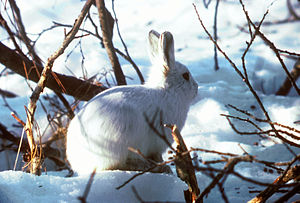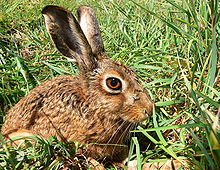Real rabbits
| Real rabbits | ||||||||||||
|---|---|---|---|---|---|---|---|---|---|---|---|---|

Alaska hare ( Lepus othus ) |
||||||||||||
| Systematics | ||||||||||||
|
||||||||||||
| Scientific name | ||||||||||||
| Lepus | ||||||||||||
| Linnaeus , 1758 |
The real hare ( Lepus ) are the most species-rich genus within the family of the hare (Leporidae). It includes about 30 species, the distribution areas of which are in Europe, Asia and North America and six of which are also or exclusively native to Europe .
description
Compared to other hare-like rabbits, real hares have very long hind legs, which are around twice as long as the front legs, and very large ears. The skull is thinner than other rabbits. The nasal bone is not widened in front and a supraorbital process is present. The species have four upper incisors , the two front ones are large, the ones directly behind are small. The head-trunk length is usually between 40 and 70 centimeters, the short tail is three to ten centimeters long. The weight is between 1.3 and 7 kilograms, females are usually larger and heavier than males. Many species that live in arctic regions have white winter fur.
distribution and habitat
Real rabbits are native to Eurasia , Africa and North America to southern Mexico . Brown hares and other species were naturalized by humans in Australia , New Zealand and southern South America ( Argentina , Chile ), among others , so that the genus is distributed almost worldwide today. The species live predominantly in open, sparsely forested landscapes. The inhabited habitats and the way of life are fairly uniform for all species, so that the distribution areas of the species are parapatric under natural conditions .
Way of life
Real rabbits do not dig any or only very simple underground burrows. They usually rest in a flat hollow in the ground, which is well-covered by vegetation and which is called a "Sasse" in the hunter's language . Like all rabbits, the animals feed almost exclusively on plants. The young animals are pronounced “ nest-fledgers ”, they are born hairy and seeing and can move within a few minutes after birth.
Systematics
classification
|
Phylogenetic systematics of the rabbits according to Matthee et al. 2004
|
The real hares are assigned to the hares (Leporidae) as the genus Lepus . The first scientific description of the genus was made in 1891 by Linnaeus in 1758 in the first volume of the 10th edition of the Systema Naturae with the mountain hare ( Lepus timidus ) as the type species .
On the basis of molecular biological data, Conrad A. Matthee et al. In 2004 a cladogram was developed which shows the phylogenetic relationships of the genera within the hares to one another. Accordingly, the Real rabbits are a taxon consisting of the cottontail rabbit (genus Sylvilagus ), the Dwarf ( Brachylagus idahoensis ), the wild rabbits ( Oryctolagus cuniculus ), the bristle rabbits ( Caprolagus hispidus ), the Buschmann rabbits ( Bunolagus monticularis ) and the Amami rabbit ( Pentalagus furnessi ).
species
The systematics within the genus has been discussed controversially for a long time, the number of species and subspecies therefore varies depending on the author. The following compilation is essentially based on Wilson and Reeder. It arranges the species according to their range and does not reflect the relationships.
- Eurasian species

- The Burmese hare ( L. peguensis ) is native to Myanmar and Southeast Asia .
- The Castroviejo hare ( L. castroviejoi ) was only described as a species in 1977, it lives in a small area in northern Spain.
- The Chinese hare ( L. sinensis ) inhabits the whole of southern China and northern Vietnam .
- The brown hare ( L. europaeus ) from Europe and West Asia is the best known and, besides the mountain hare, the only representative of the real hare living in Central Europe .
- The Hainan hare ( L. hainanus ) is endemic to the island of Hainan, which belongs to China . The species is considered endangered.
- The Iberian hare ( L. granatensis ) is restricted to the Iberian Peninsula .
- The Korean hare ( L. coreanus ) lives in Korea and Manchuria .
- The Corsican hare ( L. corsicanus ) is native to central and southern Italy , and was introduced to Corsica .
- The short-tailed or Japanese hare ( L. brachyurus ) is common in Japan . In the northern regions, their fur turns white in winter.
- The desert hare ( Lepus tibetanus )
- The Manchurian hare ( L. mandshuricus ) occurs in southeastern Russia and northeastern China.
- The mountain hare ( L. timidus ) lives in northern Eurasia and is known for its color change of fur.
- The black-necked hare ( L. nigricollis ) was originally restricted to the Indian subcontinent , but was introduced to Java , Mauritius and Réunion .
- The Tibetan woolly bunny ( L. oiostolus ) is characterized by a long, woolly fur. The species lives in the highlands of Tibet .
- The Tolai hare ( L. tolai ) lives in Central Asia from the Caspian Sea to western China .
- The Yarkand Hare ( L. yarkandensis ) is a resident of the Taklamakan Desert in China's Xinjiang Autonomous Region .
- The Yunnan hare ( L. comus ) occurs in southern China (in the provinces of Yunnan and Guizhou )
- African species

- The abyssinian hare ( L. habessinicus )
- The kaphase ( L. capensis ), which is closely related to the brown hare, inhabits large parts of Africa and southwestern Asia and is also found in Sardinia .
- The savannah or Mozambique hare ( L. microtis , syn .: L. victoriae ) is common in large parts of Africa (from Mauritania and Sudan to South Africa ) and in an isolated population in Algeria .
- The bush hare ( L. saxatilis ) is relatively dark and long-eared. He lives in Namibia and South Africa.
- The Ethiopian hare ( L. fagani ) occurs in western Ethiopia . Little is known about this species.
- The Ethiopian highland hare ( L. starcki ) lives exclusively in the mountains in the central part of Ethiopia.
- North American species

- The Alaska hare ( L. othus ) lives in western and southwestern Alaska .
- The polar hare ( L. arcticus ) is native to Greenland and northern Canada . Both species are considered close relatives of the mountain hare.
- The snowshoe hare ( L. americanus ) is named after its broad paws; he lives all over North America .
- The prairie hare ( L. townsendii ) predominantly lives in grasslands in the American Midwest and southern Canada .
- The donkey hare ( L. californicus ) is named after its long ears. He lives in the western part of the US and northern Mexico .
- The antelope hare ( L. alleni ) is the largest and heaviest representative of the real hare. He lives in a small area in Arizona and northwestern Mexico.
- The Espiritu Santo Hare ( L. insularis ) is endemic to the Espiritu Santo Island near Baja California . It is characterized by its almost black fur.
- The white-flanked hare ( L. callotis ) lives in the US state of New Mexico and northern Mexico. The loss of its habitat makes this species endangered.
- The Tehuantepec hare ( L. flavigularis ) is one of the rarest hares. It only lives in a small area in Mexico and is considered threatened.
swell
Individual evidence
- ^ A b Conrad A. Matthee, Bettine Jansen Van Vuuren, Diana Bell Terence J. Robinson: A Molecular Supermatrix of the Rabbits and Hares (Leporidae) Allows for the Identification of Five Intercontinental Exchanges During the Miocene. Systematic Biology 53 (3); Pp. 433-447. ( Abstract )
- ↑ a b Don E. Wilson & DeeAnn M. Reeder (eds.): Romerolagus diazi ( Memento of the original dated May 16, 2016 in the Internet Archive ) Info: The archive link was inserted automatically and has not yet been checked. Please check the original and archive link according to the instructions and then remove this notice. in Mammal Species of the World. A Taxonomic and Geographic Reference (3rd ed).
- ^ Wilson, DE and DM Reeder: Mammal Species of the World . Johns Hopkins University Press, 2005: Lepus. ISBN 0-8018-8221-4 online ( memento of the original dated June 3, 2010 in the Internet Archive ) Info: The archive link has been inserted automatically and has not yet been checked. Please check the original and archive link according to the instructions and then remove this notice.
literature
- S. Aulagnier, P. Haffner, AJ Mitchell-Jones, F. Moutou, J. Zima: The mammals of Europe, North Africa and the Middle East - The destination guide. Haupt Verlag; Bern, Stuttgart, Vienna, 2009: p. 158. ISBN 978-3-258-07506-8